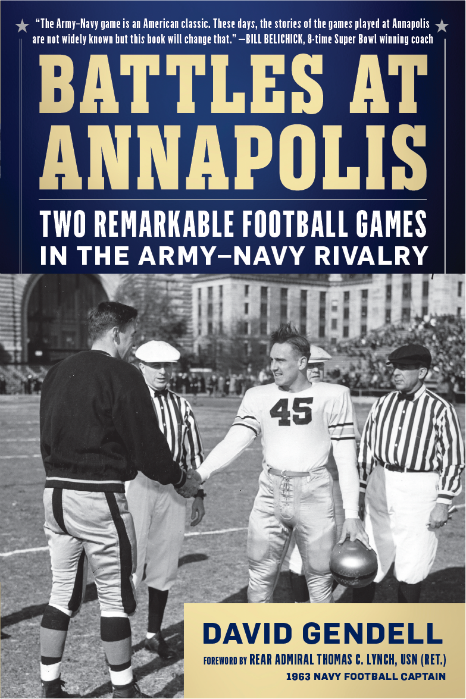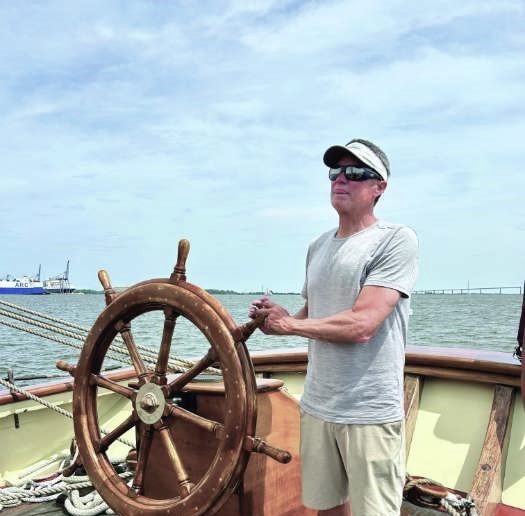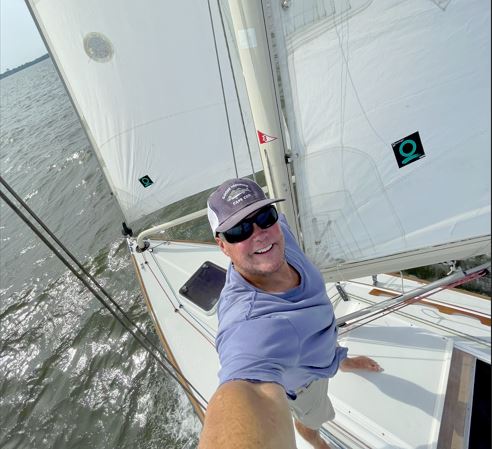An Annapolis Sailor and Author Tackles Navy Football in his New Book
Since his first nonfiction book, “Thomas Point Shoal Lighthouse,” appeared in 2020, SpinSheet co-founder and Annapolis sailor, author, and historian Dave Gendell has published two more: “The Last Days of the Schooner America: A Lost Icon at the Annapolis Warship Factory” (2024) and “Battles at Annapolis: Two Remarkable Football Games in the Army-Navy Rivalry (August 2025). Our editor reached out to Dave to hear about his new book:

Your latest book, “Battles at Annapolis,” was originally entwined in your schooner book. When did it take on a life of its own?
As I researched the Schooner America and the Annapolis Yacht Yard, I quickly learned that there were a lot of interesting and special things happening all at once in Annapolis in the first months of World War II, specifically in the fall of 1942. The America, an intense warship building program in Eastport, Dr Robert Goddard and his team working in secret at the North Severn Naval Station, and an accelerated program at the Naval Academy including hundreds of new “reserve midshipmen” on the scene. At the same time, Annapolis was a “Navy Town,” and the local reaction to the war was intensely patriotic and full of action. My original goal was to pull all of these together and focus on one specific timeframe in the fall of 1942.
When I learned that the 1942 Army-Navy football game was played at the US Naval Academy under unique circumstances, on the edge of Spa Creek and the Severn River, I knew that this story needed to be told on its own. The three stories—America and the Annapolis Yacht Yard, the Army-Navy Game, and the Goddard story—each were compelling enough to stand on their own. Diving into the 1942 football game quickly brought me to the prior time Army-Navy had been played at Annapolis in 1893. That game was more than unique; it was extraordinary. Once I found some connections between the two games, it was obvious that they could be paired together under one title.
What first intrigued you about these historic football games?
Ironically, I did not play football, nor did I attend a service academy, but I did grow up in Annapolis and graduated from elementary school and high school just a few hundred yards from the Academy. I know the feeling in town when something big is happening there. The idea that both Army-Navy games were played at Annapolis, on the edge of the Severn River, was deeply intriguing. In the course of my research, I learned that beyond their location, these two games featured extraordinary circumstances and extraordinary individuals.
The 1893 game was played by sons of Civil War veterans, from both sides of that conflict. It featured the first appearance of a goat mascot. It featured the first football helmet. It was a hard-hitting, closely fought game, and things got out of control in the stands. After news of the scene at the game reached the president and his cabinet, the rivalry was paused and would not resume for six years.
The 1942 game was nearly cancelled due to the war and only scheduled at the insistence of President Franklin Roosevelt. Due to travel restrictions, the Corps of Cadets were not permitted to travel from West Point to Annapolis. As a result, half of the Brigade of Midshipmen were ordered to cheer for Army. Players from this game, on both teams, went on to remarkable service in World War II.

What did your research for the new book entail?
A lot of archival work, which I really enjoy. Sessions at The National Archives in Washington, DC, and College Park, MD, the Maryland State Archives, and the Nimitz Library at the Naval Academy were very productive. In 1893, especially, a handful of top college football teams captured the imagination of the nation. Army and Navy were among them. I found hundreds of detailed newspaper accounts of the teams and their games.
Of course, like so many good things, I first wrote about these games for a SpinSheet Chesapeake Classic story.
Who is your favorite character from this book?
Joseph Mason Reeves came to the Naval Academy from Illinois and was a centerpiece of the 1893 game. He played at the center of the line on both offense and defense. He delivered and received some tremendous contact in the games and was nicknamed “Bull” for his hard-charging style of play. At the same time, he was one of the Academy’s brightest young engineering minds. Reeves went on to an amazing Navy career and later became a four-star admiral. He was recalled to service during the World War and spent time at the Annapolis Yacht Yard. When I located a photo of Reeves (in the Annapolis Maritime Museum’s collection) attending a Yacht Yard launch of a patrol torpedo boat, I knew I had found an extraordinary character.

Is there any sailing in this book?
As part of the program at the Academy, the 1893 Navy players spent hours aboard sailing ships and were taught rigging, sail handling, and how to fight the ship. This happened even after steam warships emerged as the primary Navy platform. A few years after the game, a star Navy player was deeply involved in a remarkable small boat combat engagement on the north coast of Cuba. I spent a lot of time working on that section, and while it is not “under sail,” there is plenty there for those who love boats.
Do you have any upcoming lectures or book signings SpinSheet readers should know about?
I will be part of the program at the Sultana Downrigging Festival in Chestertown this fall. I will talk about the Schooner America book at the Festival on November 1 at 1 p.m.
How can we purchase your books?
For those who prefer to shop locally, you can find the Schooner book at Old Fox (Annapolis), the Chesapeake Bay Maritime Museum (St. Michaels), The Mariners Museum (Newport News, VA), and the Annapolis Maritime Museum.
All of the books are available at the usual online outlets. Buying directly from the publisher is always a good option, too. The Thomas Point book can be found at arcadiapublishing.com and the Schooner and Football books at globepequot.com.
Read our last Q&A with the author here.




